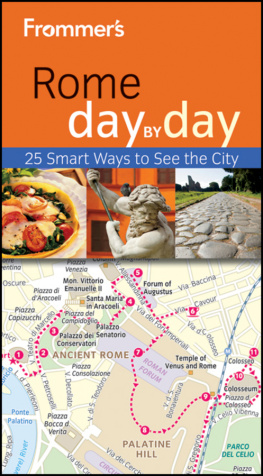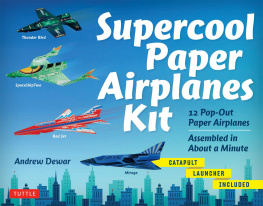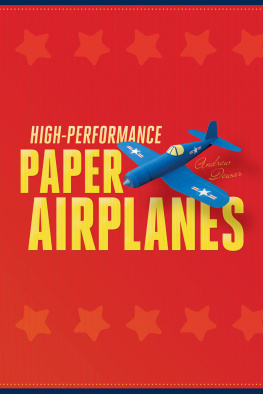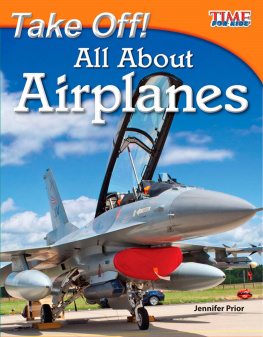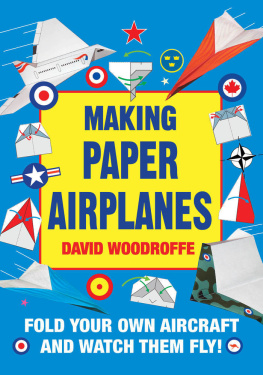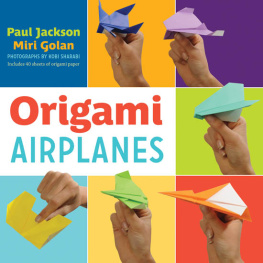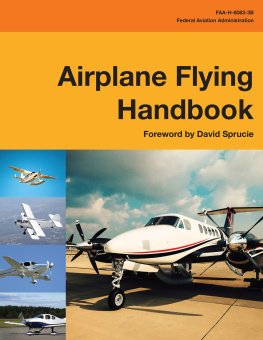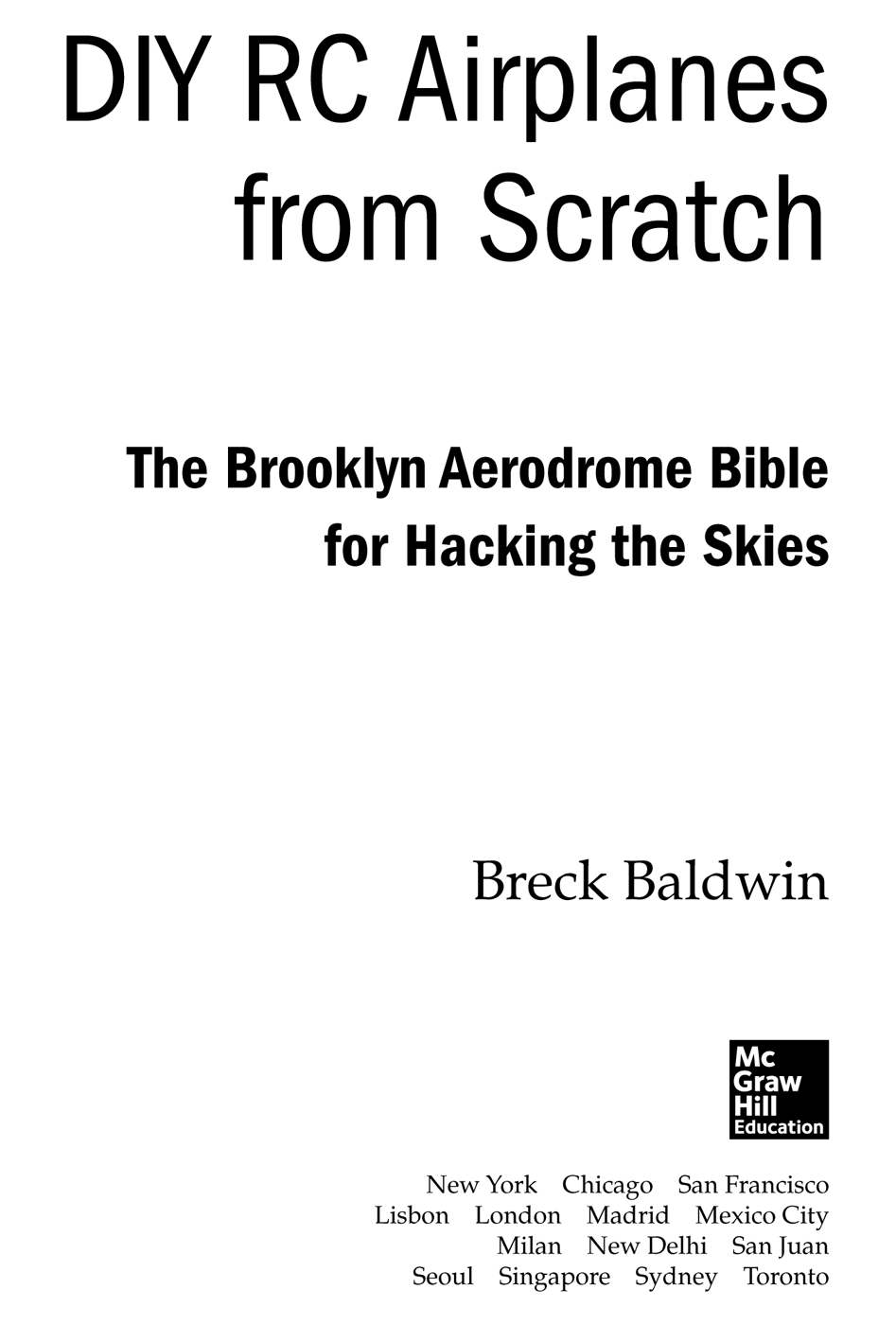About the Author
Breck Baldwin has been building and flying model aircraft since he was a child. He founded the Brooklyn Aerodrome in 2005 to support flying art, education, and technology developments around remote-controlled aircraft. Breck authored a cover story for Make magazine, Volume 30, featuring the Flack. He designs custom art planes for festivals, corporate events, and fun. He has led Flack building sessions at summer camps, schools, and various institutions. Breck has a Ph.D. in computer science from the University of Pennsylvania and is the president and founder of LingPipe.
Copyright 2013 by McGraw-Hill Education. All rights reserved. Except as permitted under the United States Copyright Act of 1976, no part of this publication may be reproduced or distributed in any form or by any means, or stored in a database or retrieval system, without the prior written permission of the publisher.
ISBN: 978-0-07-181005-0
MHID: 0-07-181005-6
The material in this eBook also appears in the print version of this title: ISBN: 978-0-07-181004-3, MHID: 0-07-181004-8.
All trademarks are trademarks of their respective owners. Rather than put a trademark symbol after every occurrence of a trademarked name, we use names in an editorial fashion only, and to the benefit of the trademark owner, with no intention of infringement of the trademark. Where such designations appear in this book, they have been printed with initial caps.
McGraw-Hill Education eBooks are available at special quantity discounts to use as premiums and sales promotions or for use in corporate training programs. To contact a representative please visit the Contact Us page at www.mhprofessional.com.
McGraw-Hill Education, the McGraw-Hill Education logo, TAB, and related trade dress are trademarks or registered trademarks of McGraw-Hill Education and/or its affiliates in the United States and other countries and may not be used without written permission. All other trademarks are the property of their respective owners. McGraw-Hill Education is not associated with any product or vendor mentioned in this book.
Information contained in this work has been obtained by McGraw-Hill Education from sources believed to be reliable. However, neither McGraw-Hill Education nor its authors guarantee the accuracy or completeness of any information published herein, and neither McGraw-Hill Education nor its authors shall be responsible for any errors, omissions, or damages arising out of use of this information. This work is published with the understanding that McGraw-Hill Education and its authors are supplying information but are not attempting to render engineering or other professional services. If such services are required, the assistance of an appropriate professional should be sought.
TERMS OF USE
This is a copyrighted work and McGraw-Hill Education and its licensors reserve all rights in and to the work. Use of this work is subject to these terms. Except as permitted under the Copyright Act of 1976 and the right to store and retrieve one copy of the work, you may not decompile, disassemble, reverse engineer, reproduce, modify, create derivative works based upon, transmit, distribute, disseminate, sell, publish or sublicense the work or any part of it without McGraw-Hill Educations prior consent. You may use the work for your own noncommercial and personal use; any other use of the work is strictly prohibited. Your right to use the work may be terminated if you fail to comply with these terms.
THE WORK IS PROVIDED AS IS. McGRAW-HILL EDUCATION AND ITS LICENSORS MAKE NO GUARANTEES OR WARRANTIES AS TO THE ACCURACY, ADEQUACY OR COMPLETENESS OF OR RESULTS TO BE OBTAINED FROM USING THE WORK, INCLUDING ANY INFORMATION THAT CAN BE ACCESSED THROUGH THE WORK VIA HYPERLINK OR OTHERWISE, AND EXPRESSLY DISCLAIM ANY WARRANTY, EXPRESS OR IMPLIED, INCLUDING BUT NOT LIMITED TO IMPLIED WARRANTIES OF MERCHANTABILITY OR FITNESS FOR A PARTICULAR PURPOSE. McGraw-Hill Education and its licensors do not warrant or guarantee that the functions contained in the work will meet your requirements or that its operation will be uninterrupted or error free. Neither McGraw-Hill Education nor its licensors shall be liable to you or anyone else for any inaccuracy, error or omission, regardless of cause, in the work or for any damages resulting therefrom. McGraw-Hill Education has no responsibility for the content of any information accessed through the work. Under no circumstances shall McGraw-Hill Education and/or its licensors be liable for any indirect, incidental, special, punitive, consequential or similar damages that result from the use of or inability to use the work, even if any of them has been advised of the possibility of such damages. This limitation of liability shall apply to any claim or cause whatsoever whether such claim or cause arises in contract, tort or otherwise.
This book is dedicated to Robert Cooper, who inspired me with his beautiful airplanes as a child, and my 7th-grade science teacher, Bob Parsons, who taught me how to fly and finish what I started.
Contents
Introduction
Welcome to the world of do-it-yourself (DIY) remote-control airplanes. In this book you will learn how to build your own motorized model aircraft from scratch using materials and tools that are widely available and relatively inexpensive. Youll also learn the skills you need to get your plane into the air and keep it there. By the end of the book, you should be able to create your own customized designs, limited only by your imagination and by the laws of aerodynamics.
Book Overview
This book starts off with very detailed instructions on how to get our Flack (flying + hack) delta wing provisioned, understood, built, flown, and repaired in six chapters that break down as follows:
presents a shopping list and possible sources of gear, including a Brooklyn Aerodrome kit.
describes the parts of the Flack and what the parts do.
details building the deck. The deck houses all the components that control and power the Flack in a tough, resilient form. When the foam airframe is too floppy to fly, then the deck is simply removed and attached to a new airframe.
covers building an airframe from foam sheeting.
gets you flying. I am surprised by and delighted with how well the flying chapter worksI was not sure that one could learn to fly from text and photos. Some aspects of flying are fundamentally hard, such as turning, but this chapter helps you to ease into the skill one crash at a time.
offers checklists, repair diagnostics, and crash kits that will keep you flying.
There will be supporting materials on the book website (http://brooklynaerodrome.com/bible) that fill out with video what the text and photos struggle with. If you get stuck, fire off an e-mail, but try to figure it out on your own for a while firstyou will learn more. Please build a Flack and send a picture to bible@brooklynaerodrome.com. It makes my day every time I get an e-mail with a successful build.
should come with the warning sign, Welcome to the Deep End. This is where discussions are more high level and you are expected to do your own research, fill in the blanks, and generally act like the DIY hero that you are. If this was a cookbook, then the recipes would be more like suggested dishes with some guidance on pitfalls and approaches.
comes direct from the art department: How to make planes look good during the day. Lots of things have been tried, and some work better than others. This is my assembled knowledge for day fliers.






